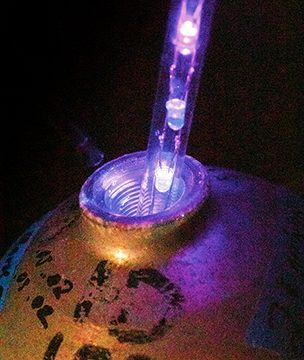Partie 1 : Quand procéder à l'épuration d'oxygène
LES INCENDIES DANS LES ÉQUIPEMENTS D'OXYGÈNE COMPRIMÉ sont rares, même si nous entendons parler d'accidents potentiellement mortels - un incendie de recycleur, un accident de régulateur d'oxygène d'urgence ou un incendie de système de mélange de gaz.
Plusieurs questions essentielles se posent : Pourquoi les situations où les niveaux d'oxygène sont élevés et où les mains ou les établis sont sales ne provoquent-elles pas toujours un incendie ? Quelle est la quantité d'oxygène suffisante dans un gaz respiratoire pour augmenter le risque d'incendie ?
La réponse à la première question se trouve dans le terme statistique "probabiliste". Il arrive que des matériaux placés dans 100 % d'oxygène à 2 000 psi et chauffés à 400°F s'enflamment spontanément. Parfois, ils ne s'enflamment pas. S'il y a une raison à cela, il est probable que même les scientifiques les plus qualifiés ne pourront pas l'expliquer complètement. Mais nous devons faire preuve de prudence. Aucun feu d'oxygène n'est acceptable, et des blessures graves ou des décès sont souvent à déplorer.
Le nombre de molécules d'oxygène dans une bouteille de plongée remplie d'air à 3 000 psi est 207 fois supérieur à ce que l'on trouve dans l'atmosphère. Il existe d'autres facteurs, mais même une bouteille de plongée chargée peut être considérée comme enrichie en oxygène.
Les incendies dans nos systèmes d'air sont extrêmement rares. Si l'on fait abstraction des sources d'inflammation et des matériaux inflammables, nous nous concentrons sur les situations où la quantité d'oxygène augmente le risque d'incendie.
De nombreux codes, normes, spécifications, lignes directrices et pratiques industrielles donnent des définitions différentes des gaz respiratoires enrichis en oxygène. Nous entendons dire que 40 % de nitrox ne nécessite pas d'équipement de nettoyage à l'oxygène. Comment connaître le niveau acceptable et sûr avec toutes ces informations contradictoires ?
Le tableau 1 résume les références indiquant quand le gaz est enrichi en oxygène. De manière réaliste, nous pourrions fixer la limite à 25 % maximum, mais il est important de se demander où le niveau a été testé, quelle est la pression maximale prévue et comment l'oxygène est obtenu au-delà de 21 %.
Les recherches menées par la marine dans les années 1960 et 1970 comprenaient des études sur les incendies avec différents niveaux d'enrichissement en oxygène, des mélanges de gaz respiratoires et des pressions environnementales. Les résultats ont montré qu'à mesure que la pression augmente, la vitesse de flamme des matériaux s'accroît rapidement avec l'augmentation des concentrations d'oxygène. Au-delà de 25 %, la vitesse de combustion augmente rapidement. À 40 % d'oxygène et 90 psi, la vitesse de combustion est 50 % plus élevée que les 21 % d'oxygène de l'air normal. À des pressions plus élevées, 40 % se transforme rapidement en boule de feu.
Pour les applications à plus basse pression, telles que les ombilicaux de plongée commerciale, les niveaux d'oxygène peuvent être supérieurs à 25 %. À la pression de 3 000 psi d'une bouteille de plongée, les paris sont ouverts.
La norme de l'American Society for Testing and Materials relative à la sélection et à la conception des matériaux de l'équipement fournit la réponse la plus défendable : Pour une utilisation à 25 % et plus, tous les équipements de plongée à haute pression doivent être nettoyés pour l'utilisation de l'oxygène.
Dans le prochain numéro de Alert DiverLa deuxième partie portera sur les critères d'épuration de l'oxygène.

Alert Diver - Q2 2022
